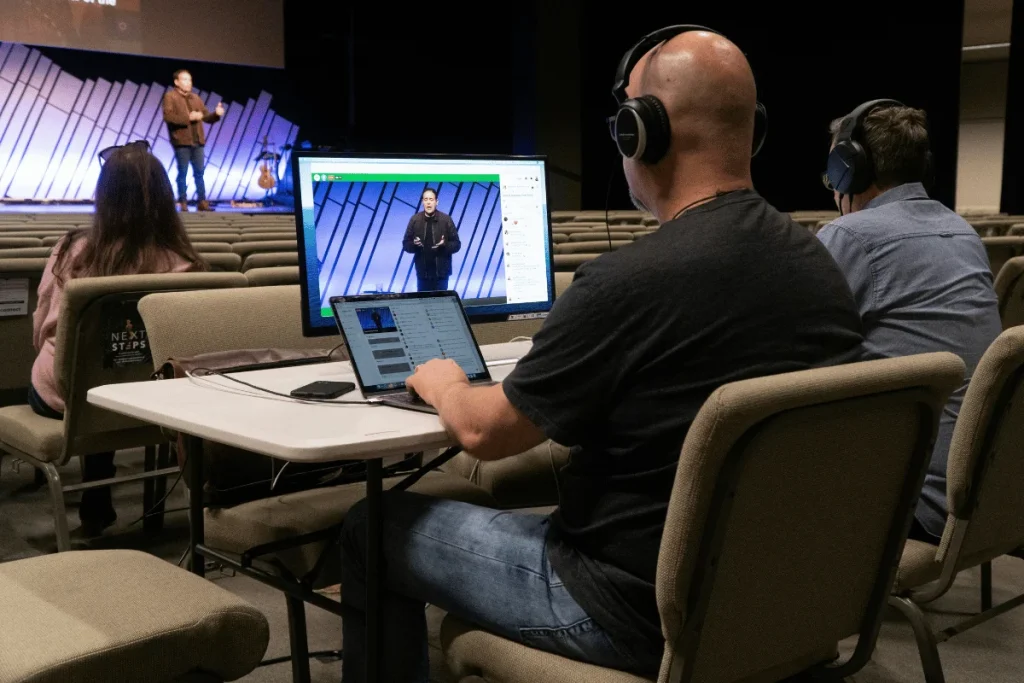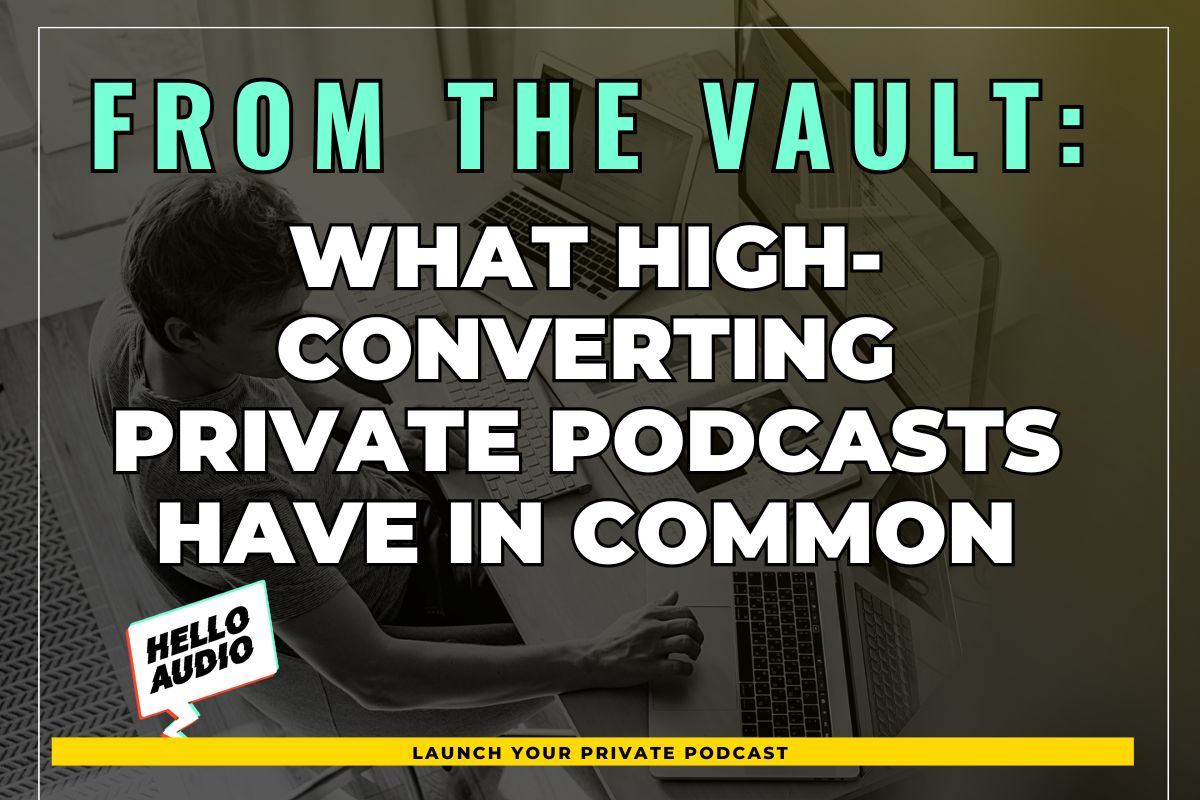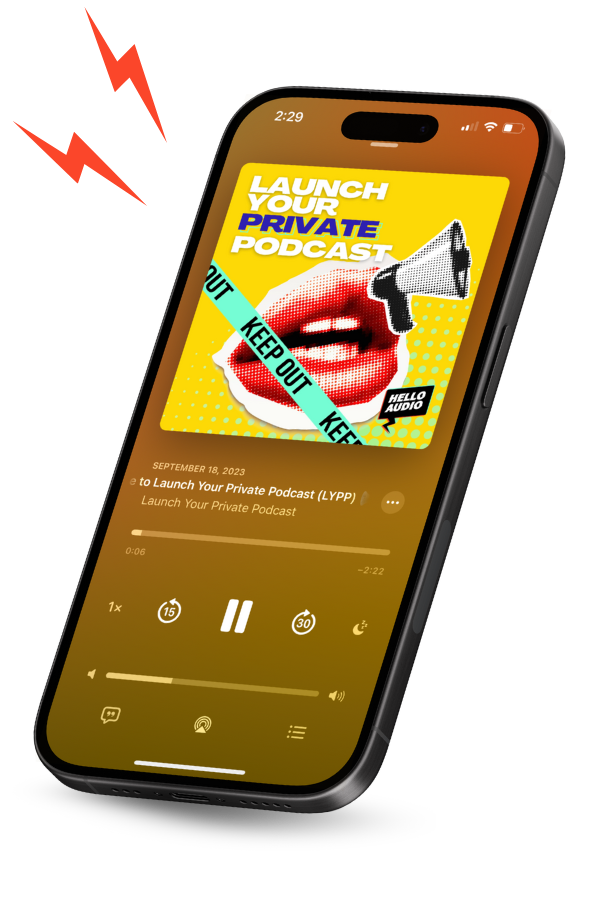About seven in 10 people report having a positive experience attending virtual events. While this number shows that most events meet their guests’ expectations, there’s still room for improvement—this is where event metrics come in!
Virtual event metrics help you determine what works or doesn’t for your audience. This way, you can refine your virtual event to deliver personalized experiences for your guests.
This article covers essential virtual event metrics to track before, during, and after your session. We also highlight some best practices when measuring the success metrics.
Need an effective way to stay connected with your guests even after the virtual event?
Hello Audio lets you repurpose your virtual event recordings into private podcasts (within minutes!) that your audience can listen to on the go. Even better, learn how to deliver private podcasts on Spotify with Hello Audio to reach a wider audience.
Sign up for our 7-day free trial and convert your virtual event recordings into engaging private podcasts!
What Are Virtual Event Metrics and Why Do They Matter
In lay terms, a metric is simply a standard or system of measurement. In this context, metrics are figures or statistics that we can use to measure the performance and efficiency of an event.
Suppose you hold monthly virtual events. You can use metrics to assess changes in attendance rate and the number of first-time guests.
Next, let’s outline why virtual events metrics matter:
- They help organizers evaluate whether a virtual event achieved its objectives, such as increased brand awareness.
- They help highlight essential areas for improvement when organizing subsequent events.
- Metrics like attendance and engagement rates help provide proof of success to sponsors.
- Tracking virtual event metrics creates a benchmark for assessing future events.

Metrics vs. KPIs in Virtual Events
Since we’ve already defined virtual event metrics, let’s understand the KPIs for virtual events before comparing these two concepts.
Key Performance Indicators for Virtual Events
KPIs are often tied to core business functions. They define a target value, which you can use as the yardstick when evaluating your progress.
Suppose your ideal attendance is 1,000 guests per event — this can be your target value (or KPI). You can then compare actual vs. target attendance to assess whether you met or missed your KPI.
Now, let’s summarize the difference between virtual event metrics vs. KPIs:
Benefits of Measuring Virtual Event Metrics
Here’s what you stand to gain from monitoring your virtual event metrics:
- Enhanced Event Planning: Engagement metrics help you personalize the event to your audience.
- Refine Your Marketing Efforts: Improve audience targeting and messaging to reach high-intent customers.
- Stakeholder Reporting: Metrics help you visualize the event’s performance. Consider total ticket sales, conversion rates, and cost per acquisition.
- Make Data-Backed Decisions: Reduced reliance on your intuition. Make decisions based on historical data to determine what works and what doesn’t.
- Effective Cost Optimization: Provide adequate resources to event activities with the most value.
Next, let’s look at the essential metrics you need to track for your virtual events.

Pre-Event Metrics
Here are the main metrics to assess in the pre-event phase:
- Email Open Rates: Even with social media, email marketing remains among the most effective ways to promote your event and drive registrations. Track how many people open your emails.
- Total Registrations: Check the number of people who sign up or reserve attendance for your virtual event. This metric helps you track the effectiveness of your virtual event marketing strategies and landing pages.
- Social Media Activity: Monitor how many reposts, comments, shares, and likes your posts receive to assess your target audience’s interest in the event.
- Conversion Rate: Track how many people visit your landing page and complete the registration.

During-Event Metrics
Let’s delve into the essential metrics to track when the event is live:
- Attendance: Check how many guests show up for the event. You can also track the number of people who attend each session.
- Average Session Duration: Monitor how long guests stay in a session to track your audience’s interest in the offered content.
- Real-Time Audience Engagement: Check engagement indicators like chat messages, cast votes, and reactions to determine active interactions.
- Technical Perfomance: Measure metrics like platform uptime, stream quality, and lag to ensure attendees have a seamless experience. These metrics also help you identify technical issues in real-time and troubleshoot them quickly so they don’t cause the guests to drop off.
- Social Media Engagement: Watch what social media users say about your event. Are they sharing live updates? Also, check whether your branded hashtag for the event is trending.

Post-Event Metrics
Watch the following metrics for a summative assessment of your event’s performance and success:
- Feedback Scores: Check what the attendees said about the event. Was it interesting? Did it meet their expectations?
- Sales-Qualified Leads: This is the number of converted leads by the end of the event.
- Generated Revenue: This entails money made from tickets, sales, and other merch on offer before, during, and after the event.
- Cost Per Attendee: For this, determine the cost of organizing the event and divide it by the number of guests. You could also calculate the cost of acquisition by dividing the total cost by the number of sales-qualified leads you got from the event.
- Net Promoter Score: This is a simple but effective measure of your event’s success. Ask your attendees how likely they are to recommend the event to others (friends, family, and colleagues).
- On-Demand Content Views: If you recorded the virtual event, check the number of people who watched the recorded sessions. Also, analyze their watch time, sections that received the most replays/engagement, and where viewers dropped off for more insight into refining your event.
The best way to increase on-demand content consumption is to convert your virtual event recordings into a format (private podcast) that your audience can consume as they go about their lives.
Hello Audio offers built-in content repurposing tools to help you convert your webinars, virtual training sessions, and social media live feeds into private podcasts within minutes. Our platform also provides detailed analytics that can help you understand your audience’s content interests—use these insights to refine your next virtual event!
Watch our instant demo to understand how Hello Audio helps you repurpose your virtual events while providing deep insights on personalizing them to match expectations.

Best Practices for Tracking Virtual Event Metrics
Use our cheatsheet below to track your virtual event metrics effectively:
- Have Clear Goals: Defining your event’s objectives helps you identify the right performance metrics to track. Suppose you organize a virtual event for product activation. Besides usual metrics like attendance and engagement, you should track sales-qualified leads to determine whether the event was successful.
- Pick the Right Platform: Prioritize platforms that allow you to track basic performance metrics, such as registrations, click-through rates, and on-demand views.
- Analyze Your Guests’ Demographics: Group your audience based on age, profession, and location for better targeting.
- Track Metrics Across All Phases: Measure relevant variables before, during, and after the virtual event for a comprehensive assessment of the event.
- Check Engagement Rates: Chat messages, social media activity, and voting patterns can help determine how many guests actively participated in your event.
- Automate the Tracking Process: Integrate third-party virtual events analytics tools for hands-free performance tracking. This lets you focus on core event activities and give your guests a befitting experience.
- Get Actionable Insights: Analyze the virtual event metrics to identify available improvement opportunities and streamline your workflows to deliver better audience experience in the future.
![]()
Frequently Asked Questions (FAQs)
Find answers to common questions organizers ask about tracking virtual event metrics:
What Are the Tools for Measuring Virtual Event Metrics?
There are various tools you can use to track your event’s metrics:
- Use Google Analytics to track user behavior when people visit your landing pages.
- Use HubSpot to track email interactions.
- Integrate Mixpanel and Hotjar to monitor user actions and heatmaps within the virtual event platform.
- Create SurveyMonkey forms to collect post-event feedback.
What is a Good Attendance Rate for a Virtual Event?
There is no standard benchmark for assessing virtual event attendance rates. It depends on the event type, ticket prices, and time.
However, a 50% attendance rate is considered average.
How Do I Calculate Cost Per Attendee for Virtual Events?
Use this formula to calculate the cost per attendee for your virtual event:
Cost per Attendee = Total Cost of Organizing the Event / Total Number of Attendees
Conclusion
Use the metrics highlighted in this blog to track your virtual event’s success, especially how your audience resonated with the content (Did it meet their expectations?) and overall satisfaction scores (Would they attend another event?).
The metrics should also help seal budget leaks to deliver a higher ROI for your virtual event sponsors.
Pro Tip: Use Hello Audio to repurpose your virtual event recordings into private podcasts to maximize the content’s lifespan and realized ROI. Also, you can use the private podcasts to build a community around your brand, which provides a ready audience for future virtual events.
Sign up for Hello Audio’s 7-day free trial for an easy way to connect with your audience before and after your virtual events!












